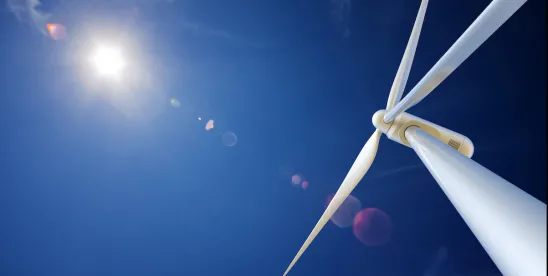On July 4, 2025, President Trump signed the One Big Beautiful Bill Act (OBBBA) into law, significantly revising the U.S. tax code to reflect the Administration’s domestic energy, trade, and national security priorities. Among its most consequential provisions are statutory amendments to the Section 45Y Clean Electricity Production Tax Credit and Section 48E Clean Electricity Investment Tax Credit – two cornerstone clean energy tax credits originally enacted under the Inflation Reduction Act (IRA) to replace the long-standing investment tax credit (ITC) and production tax credit (PTC), which had been in place for decades.
Although the OBBBA preserves the foundational technology-neutral structure of the 45Y and 48E credits, it introduces key limitations, including:
- Rapidly accelerating sunset of incentives for solar and wind projects;
- New foreign entity restrictions; and
- A revised domestic content regime.
In addition, Executive Order No. 14315: Ending Market Distorting Subsidies for Unreliable, Foreign Controlled Energy Sources (July 7, 2025) signals further executive and regulatory actions are forthcoming, particularly in alignment with trade policy and critical supply chain concerns.
At the same time, other renewable energy sources remain largely unaffected by the recent changes to the 45Y and 48E tax credits introduced in the OBBBA. In particular, the law appears to reinforce the fuels-based approach, preserving support for technologies such as biogas and biofuels. Additionally, fuel cells, cogeneration, geothermal, and nuclear energy are also left intact under the updated 45Y and 48E frameworks. These technologies continue to qualify for clean electricity tax credits, assuming they meet the emissions and labor-related eligibility criteria. The preservation of this broad eligibility signals continued support for a diverse range of clean energy sources beyond wind and solar.
Background: The 45Y and 48E Credits Under the IRA
The Energy Tax Act of 1978 created early forms of a renewable energy ITC. After intermittent renewals and modifications, the Energy Policy Act of 1992 established a permanent 10% ITC for certain technologies. The bipartisan Energy Policy Act of 2005, signed into law by President George H. W. Bush, further solidified the ITC, setting its value at 30% but enacting sunset provisions.
Over the years, the ITC has been repeatedly extended for solar and wind technology, typically in a bipartisan fashion, with different sunset and percentage provisions. Similarly, PTCs originated in the early 1990s and have persisted in various forms since, with changes to eligible sources, percentages, and sunset provisions adopted by different Congresses, again typically in a bipartisan manner.
The IRA created sections 45Y and 48E to replace the historic patchwork of technology-specific credits with a streamlined, technology-neutral tax incentive framework for clean electricity generation. Unlike prior legislation, this was a less bipartisan process, with Vice President Kamala Harris casting the deciding tie-breaking vote in the Senate, which passed the IRA on a 51-50 vote; the House vote passed on pure party lines, with a 220-207 vote.
- Section 45Y: a production tax credit (PTC) for electricity generated by qualifying clean electricity facilities.
- Section 48E: an investment tax credit (ITC) for capital investment in qualifying energy property, including energy storage.
To qualify under either of these tax credit programs, facilities were required to be:
- Placed in service after 2024; and
- Have zero emissions, defined by a lifecycle greenhouse gas (GHG) emissions rate of zero (or anticipated to be zero).
Both credits featured base and bonus rates (e.g., for domestic content, energy communities, and labor compliance), a 10-year duration requirement (from placed-in-service date), and a statutory phaseout beginning in 2032, unless net U.S. electricity sector GHG emissions are at least 75% below 22 levels. The credits were to start phasing out in 2032 or earlier if the U.S. achieved a reduction in GHG emissions from the electricity sector that is 25% of 2022 levels.
Treasury and the IRS issued final regulations in January 2025 interpreting eligibility, documentation, emissions methodologies, and bonus credit criteria. However, the OBBBA introduces several significant modifications that stakeholders must now incorporate into compliance and financing strategies.
Key Changes to 45Y and 48E Tax Credits
1. Accelerated phaseout for wind and solar
The OBBBA terminates eligibility for wind and solar facilities that:
- Are not placed in service by December 31, 2027, and
- Do not begin construction within 12 months of the bill’s enactment (i.e., by July 4, 2026), unless the facilities meet certain grandfathering or continuity conditions .
Notably:
- This accelerated timeline only affects solar and wind technologies.
- Other clean electricity technologies retain the original IRA phaseout (starting in 2032).
- The provision does not affect projects that are already in service or those that begin construction before July 4, 2026.
Developers should expect:
- Increased pressure on permitting, interconnection, supply chain contracting, and labor procurement,
- Potential credit qualification bottlenecks, and
- Urgent need to document construction start dates and placed-in-service dates consistent with IRS standards (including the forthcoming revised standards).
2. Foreign Entity of Concern (FEOC) and Material Assistance Restrictions
The OBBBA expands and operationalizes FEOC restrictions first contemplated in the IRA, but not yet implemented in prior Treasury rulemakings.
Key definitions:
- Prohibited Foreign Entities (PFE): Includes both
- Specified Foreign Entities (SFEs) – entities on U.S. sanctions or control list,
- Foreign-Influenced Entities (FIEs) – entities majority-owned or controlled by SFEs.
- Material Assistance Test: Facilities may not claim 45Y or 48E credits if they receive “material assistance” from PFEs.
- The Material Assistance Cost Ratio measures this. Ratio = (PFE-sourced product cost/Total manufactured product cost)
- If the ratio exceeds a forthcoming Treasury-prescribed threshold, the facility is ineligible.
Effective dates:
- Generation facilities: Ineligible if construction starts after June 16, 2025.
- Energy storage facilities: Ineligible if construction starts after December 31, 2025.
Developers should expect:
- FEOC rules will likely require detailed supplier audits and origin tracing, including for subcompanies.
- Ongoing Treasury guidance is expected to define the applicable threshold and documentation standards.
3. Increased Domestic Content Requirements
The OBBBA strengthens the domestic content bonus credit requirements and increases required thresholds based on construction start dates:
- 40% (or 20% for offshore wind) if construction begins before June 16, 2025.
- 45% (or 27.5% for offshore wind) if construction begins after June 16, 2025, and before January 1, 2026.
- 50% (or 35% for offshore wind) if construction begins during 2026.
- 55% for all facilities if construction begins after December 31, 2026.
4. Other Targeted Limitations and Technical Amendments
- Wind and Solar Leasing Ineligible for 48E: Facilities under certain third-party leasing or power purchase structures may not qualify for investment credits.
- Fuel Cell Property Credit Capped: Starting in 2026, 48E credits for fuel cell property are capped at a flat 30%, regardless of bonus criteria.
- Emissions Rate Standards Revised: Treasury must now rely on internationally recognized lifecycle assessment standards when publishing eligible emissions rates.
Next Steps
The OBBBA reflects a significant inflection point in federal energy and tax policy. While retaining the structure of the IRA’s technology-neutral tax credits, the Act introduces aggressive phaseouts for wind and solar eligibility. The Act also introduces geopolitical and trade-aligned constraints that narrow access for certain solar and wind projects, especially those reliant on non-U.S. supply chains.
By reinforcing domestic manufacturing requirements and excluding foreign-influenced firms, the bill aims to reshape global clean energy trade dynamics and accelerate the development of domestic value chains. However, these changes may also delay near-term deployment for some technologies, increase compliance costs, and trigger realignment in project finance strategies and cross-border investment planning.
Stakeholders should conduct legal reviews of supply chains, financing structures, and construction timelines and remain engaged in upcoming Treasury and IRS guidance processes. Wind and Solar developers should accelerate the development of current projects to gain coverage before the new phaseout dates.
All stakeholders should also monitor the increasingly volatile nature of U.S. energy policy. After several decades of relatively stable policy, first the IRA and now the OBBA reflect very different visions of American energy future. This volatility is likely to persist in a divided political climate, creating uncertainty and disruption not only for the renewable energy industry but also for supply chains, manufacturing, transmission, and power procurement around the country.
Brian Elizalde and Alexander Mangoba contributed to this article







 />i
/>i

